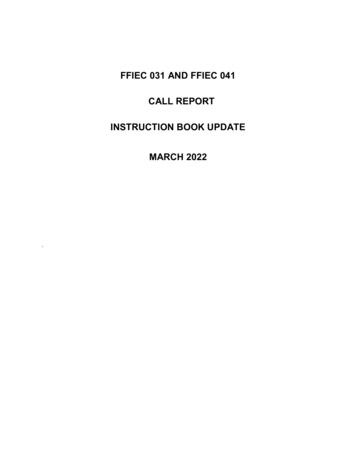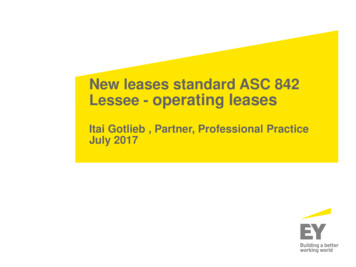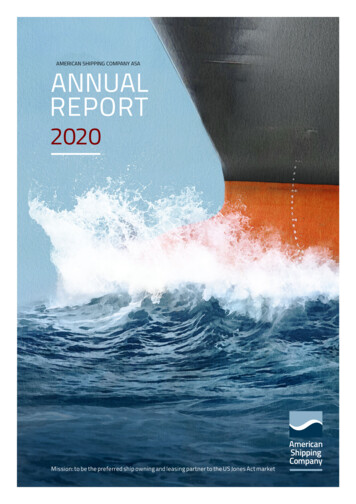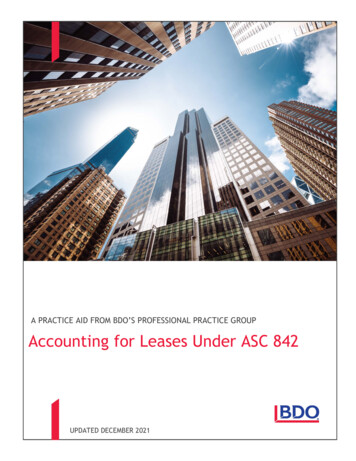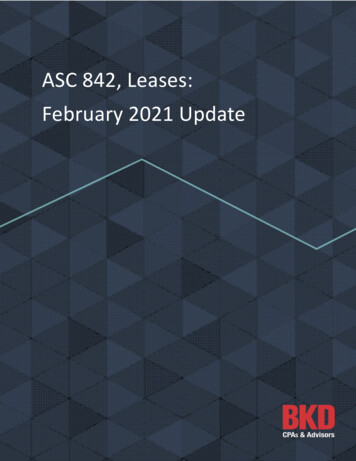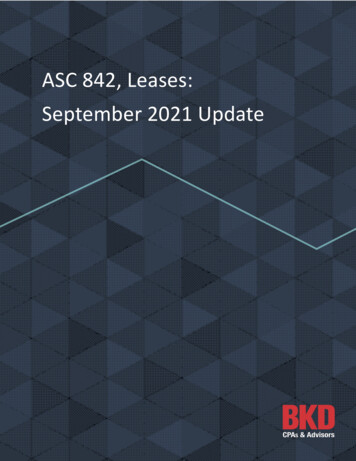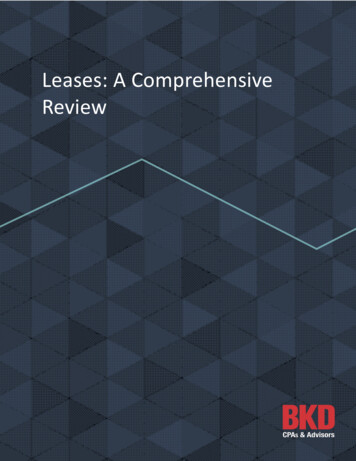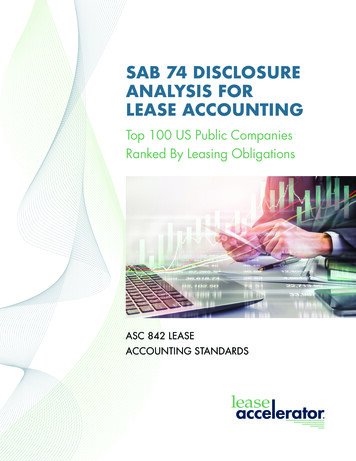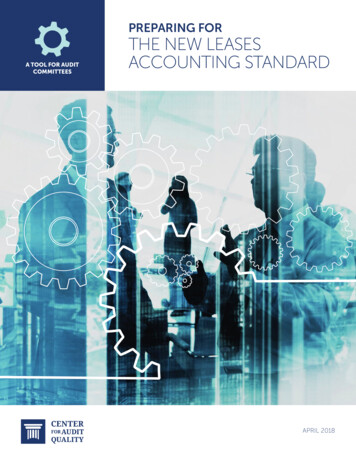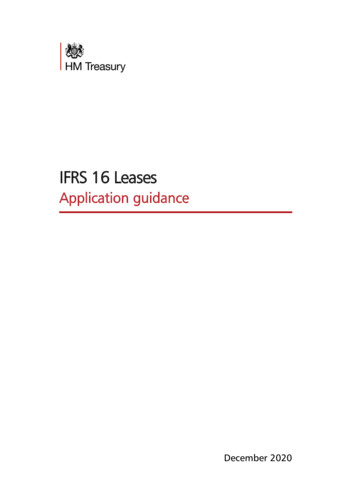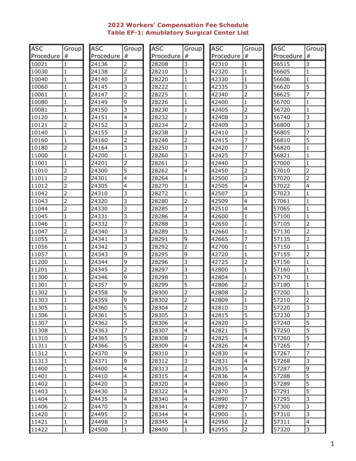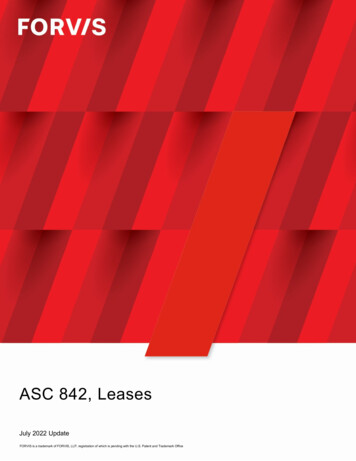
Transcription
ASC 842, Leases: July 2022 UpdateASC 842, LeasesJuly 2022 Update1FORVIS is a trademark of FORVIS, LLP, registration of which is pending with the U.S. Patent and Trademark Office
ASC 842, Leases: July 2022 UpdateTable of ContentsUpdate .5Background .5Scope .7Short-Term Leases. 7Lease Definition .8Identified Asset . 9Right to Control . 10Contract Combinations . 11Contracts with Multiple Components .12Lease Versus Nonlease Components . 12Separate Rights of Use . 15Lease Classification .15Lessee . 15Lessor . 17Initial Measurement .20Lease Term & Options. 20Lease Commencement . 20Lease Payments. 21Lease Incentives . 23Discount Rate . 24Initial Direct Costs . 27Lessee Accounting .28Operating Leases . 28Finance Leases . 29Lessor Accounting .312
ASC 842, Leases: July 2022 UpdateOperating Leases . 31Direct Financing & Sales-Type Leases . 32Subleases .34Build-to-Suit Transactions.34Sale-Leaseback Transactions .36Determining Whether a Sale Has Occurred . 36Qualified Sale . 38Failed Sale . 39Related Parties .39Reassessment .40Lease Modification . 41Classification Reassessment . 44Lease Term Reassessment . 44RVG . 45Exercise of Purchase Option During the Lease Term . 45Presentation .45Lessee . 45Lessor . 49Disclosures .50Lessee . 50Lessor . 52Transition .54Practical Expedients . 56Hindsight . 56Impairment & Exit Cost Considerations at Transition . 57BTS Transition. 58Conclusion .62Contributor .623
ASC 842, Leases: July 2022 UpdateAppendix – Identifying a Lease .634
ASC 842, Leases: July 2022 UpdateUpdateThe COVID-19 pandemic has caused unprecedented challenges in all aspects of daily life. In June 2020,FASB issued Accounting Standards Update (ASU) 2020-05, which provides nonpublic entities and notfor-profits (NFP) additional time to implement Accounting Standards Codification (ASC) 842, Leases.For NFP organizations that have issued—or are a conduit bond obligor for—securities that are traded,listed, or quoted on an exchange or an over-the-counter market, the delay is only effective if theorganization has not yet issued or made available for issuance its GAAP financial statements. The ASUalso clarifies that interim financial information posted to the Electronic Municipal Market Access (EMMA)system—non-GAAP financial information that does not include full disclosures—would not disqualify anentity from taking advantage of this lease deferral.This document has been refreshed to incorporate all subsequent standard setting and implementationguidance issued by FASB.Effective DatesASC 842(as amended)Public EntityNFP Conduit BondPrivate Companies &Annual & interim periodsObligors Annual &NFPs Annual periodsbeginning after Decemberinterim periods beginning15, 2018after December 15, 2019beginning afterDecember 15, 2021BackgroundThis is the first major overhaul of lease accounting since 1973. The new guidance requires lessees torecognize substantially all leases on their balance sheets as lease liabilities with a corresponding right-ofuse (ROU) asset. Bright-line tests have been eliminated and management judgment will increase. FASBhas updated the lease definition, and some contracts that are not currently accounted for as leases maybe considered leases under ASC 842. Less dramatic—but substantial—changes were made to thelessor accounting model to align it with changes to the lessee model and the new revenue recognitionstandard ASC 606. Leveraged lease accounting has been eliminated, although grandfathered forexisting arrangements. The guidance on related-party leases has changed—under ASC 840, relatedparty leases are based on the substance of the arrangement, whereas ASC 842 bases them on thelegally enforceable terms and conditions.5
ASC 842, Leases: July 2022 UpdateEarly adopters and large public companies found several operational challenges in implementing thestandard as written. In response, FASB finalized additional relief and technical corrections to clarifycertain aspects of the new model. This paper reviews key aspects of the new guidance, including allsubsequent amendments noted in the following table.ASU 2016-02Leases (Topic 842)ASU 2017-13SEC UpdatesASU 2018-01Leases (Topic 842): Land Easement Practical Expedient for Transition to Topic 842ASU 2018-10Codification Improvements to Topic 842, LeasesASU 2018-11Leases (Topic 842): Targeted Improvements (Comparative Reporting & Separating Lease/Nonlease Components)ASU 2018-20Narrow-Scope Improvements for Lessors (Sales & Property Tax Policy Election)ASU 2019-01Codification Improvements—Lessors (Continues Specialized Qualified Lessor Accounting)ASU 2019-10Effective Dates (Three Buckets)ASU 2020-05Effective Dates (COVID)ASU 2021-05Variable Lease PaymentsASU 2021-09Discount Rate for Private Companies & NFPsFASB acknowledged the challenge of updating long-standing accounting guidance for organizations witha sizable lease portfolio. The initial standard and subsequent amendments provide substantial relief.Most publicly traded companies are taking advantage of several of these optional reliefs. The mostpopular relief elected was the optional transition method, followed by the practical expedient packageand option not to separate lease and nonlease components. Several of the optional reliefs come withcertain reporting implications or disadvantages, however. For example, using the discount rate policyelection and not separating lease and nonlease components likely would result in larger lease liabilities.Careful consideration of each optional relief is necessary at the start of the implementation process.6
ASC 842, Leases: July 2022 UpdateTransition ElectionsOptional ReliefAccounting Policy ElectionsExpedient package – Identification, classification,initial direct costs (ASU 2016-02)Separation of lease and nonlease components forboth lessee (ASU 2016-02) and lessorHindsight (ASU 2016-02)Portfolio approach (ASU 2016-02)Land easements (ASU 2018-02)Short-term leases (ASU 2016-02)Prior-period presentation (ASU 2018-11)Discount rate (non-PBEs only) (ASU 2016-02 &ASU 2021-09)Presentation of taxes (ASU 2018-20) (lessor only)Variable lease payments (ASU 2021-05)ScopeThe scope of ASC 842 is substantially the same as ASC 840. The new model applies to all leases,including subleases, of property, plant, and equipment (PP&E). The following items are explicitlyexcluded from ASC 842: Leases of intangible assets (covered by ASC 350, Intangibles—Goodwill and Other) Leases to explore for or use minerals, oil, natural gas, and similar nonregenerative resources(covered by ASC 930, Extractive Activities—Mining, or ASC 932, Extractive Activities—Oil and Gas) Leases of biological assets, including timber (covered by ASC 905, Agriculture) Leases of inventory (covered by ASC 330, Inventory) Leases of assets under construction (covered by ASC 360, Property, Plant and Equipment)Consequential amendments address interaction with other guidance. Updates to ASC 853, ServiceConcession Arrangements, clarify the right to use the infrastructure in a service concession arrangementis not in ASC 842’s scope. Residual value guarantees (RVG) subject to ASC 842 are not subject to theguidance in ASC 815, Derivatives and Hedging.Short-Term LeasesA lessee can elect (by asset class) not to record on the balance sheet a lease whose term is 12 monthsor less and does not include a purchase option that the lessee is reasonably certain to exercise. Ifelected, the lease would be treated like an operating lease under current GAAP—payments would berecognized on a straight-line basis over the lease term. When determining whether the lease qualifies forthis election, the lessee would include renewal options only if they are considered part of the lease term,i.e., those options the lessee is reasonably certain to exercise. If the lease term increases to more than12 months, or if it is reasonably certain the lessee will exercise a purchase option, the lessee would no7
ASC 842, Leases: July 2022 Updatelonger be able to apply this practical expedient and would apply ASC 842 guidance. This is a formalpolicy election that must be disclosed along with certain other information about the short-term lease.Example – Short-Term Lease Exception PermittedABC enters into a contract to lease a piece of construction equipment for a six-month period, with theoption to extend the term for up to 12 additional months (in three-month increments). Considering thenature of the project, ABC determines that it expects to use the equipment for only nine months and isreasonably certain it will exercise only one of the four renewal options.Since the lease term is not more than 12 months, ABC would be able to elect the short-term leaseexception.Example – Short-Term Lease Exception Not PermittedABC enters into a contract to lease a piece of construction equipment for a six-month period, with theoption to extend the term for up to 12 additional months (in three-month increments). The equipment is tobe used in a project expected to take 18 months. ABC expects to use the equipment for 18 months andis reasonably certain to exercise all four renewal options.The expected lease term is greater than 12 months, so ABC would not be able to elect the shortterm lease exception.Internal controls should be developed around the evaluation of the lease term in assessing theapplicability of this exception.Lease DefinitionFASB has updated the definition of a lease. A lease only is present when a contract—or part of acontract—conveys the right to control the use of an identified asset for a period of time in exchangefor consideration. A period of time may be described in terms of the amount of use of an identified asset(the example used in the standard is “the number of production units that an item of equipment will beused to produce”).Entities will need to determine at contract inception whether a contract is or contains a lease byassessing whether—throughout the period of use—the lessee has the right to direct an asset’s use and8
ASC 842, Leases: July 2022 Updatesubstantially obtain all the economic benefits from directing its use. See the Appendix for a flowchart onidentifying a lease.Identified AssetRight to Control Explicitly or implicitly specified Not able to substitute Decision-making authority Substantially all the economicbenefitsLeaseIdentified AssetAn identified asset must be specifically identifiable in the contract either explicitly, e.g., by serial number,or implicitly, e.g., the only asset available to satisfy the lease contract, at the time the asset is madeavailable for use by the customer. An asset that is a portion of a larger asset is an identified asset if it isphysically distinct, e.g., a floor of a building or segment of a pipeline that connects a single customer tothe larger pipeline. A capacity or other portion of an asset that is not physically distinct, e.g., a capacityportion of a fiber-optic cable, is not an identified asset, unless it represents substantially all the asset’scapacity and thereby provides the customer with the right to obtain substantially all the economic benefitsfrom use of the asset.An entity will need to use significant judgment in distinguishing between a lease and a capacitycontract.Substantive Substitution RightsEven if an asset is specified, a customer/lessee may not meet the criteria for having the right to use theidentified asset. This occurs when the supplier/lessor has the substantive right to substitute an assetthroughout the use period. If a supplier has a substantive right to substitute, then the supplier—not thecustomer—controls the asset’s use. A substantive right occurs when the supplier has the practicalability to substitute alternative assets throughout the use period and would economically benefit fromexercising its right. An entity should evaluate whether a supplier/lessor’s substitution right is substantivebased on facts and circumstances at contract inception, excluding consideration of future events that, atinception, the entity did not consider likely to occur. This assessment will require management judgment,and the standard provides a few examples:9
ASC 842, Leases: July 2022 Update An agreement by a future customer to pay an above-market rate for use of the asset The introduction of new technology that is not substantially developed at contract inception A substantial difference between the customer’s asset use or the asset’s performance and the useor performance considered likely at contract inception A substantial difference between the market price of the asset during the period of use and themarket price considered likely at contract inceptionIf a customer cannot readily determine if the supplier has a substantive substitution right, the customershall presume any substitution right is not substantive.Right to ControlA contract conveys the right to control an identified asset’s use if, throughout the use period, thecustomer has the ability to obtain substantially all the economic benefits from the asset’s use anddecision-making authority to direct how and for what purpose the asset is used. Entities will make thisassessment considering all relevant facts and circumstances and may conclude the customer has theright to control an identified asset’s use for only a portion of the contract term. In that case, the contractwould contain a lease for that portion of the term.In assessing the ability to direct how and for what purpose the asset is used, decision-making rights arerelevant when they affect the economic benefits to be derived from use. For example, a customer hasthe right to direct an identified asset’s use throughout the use period if—within the scope of its right ofuse defined in the contract—it can change how and for what purpose the asset is used throughout thatperiod. The ASU includes examples of decision-making rights that may grant the right to direct how andfor what purpose an asset is used, within the defined scope of the customer’s right of use. Some factorsto consider in making this evaluation include whether the customer has the right to change the type ofoutput produced by the asset and when, where, or whether output is produced.Protective rights represent terms and conditions designed to protect the supplier/lessor’s interest in theasset, protect its personnel, or ensure the supplier’s compliance with laws or regulations. Althoughprotective rights typically define the scope of the customer’s right of use, they do not, in isolation, preventthe customer/lessee from having the right to direct an asset’s use.The right to obtain substantially all the economic benefits from the identified asset’s use throughout theperiod of use is met, for example, by having exclusive use of the asset throughout the period. A customercan obtain economic benefits from an asset’s use directly or indirectly, e.g., by using, holding, orsubleasing the asset, which includes the asset’s primary output and byproducts, including potential cashflows derived from these items, and other economic benefits from using the asset that could be realizedfrom a commercial transaction with a third party.10
ASC 842, Leases: July 2022 UpdateFor a lease to be in place, a customer must have both the power to direct the asset’s use and the abilityto obtain the benefits from its use. Current GAAP only includes the benefits component. FASB made achange to the standard by adding the control criterion to align with the new revenue recognitionstandard, which focuses on whether the lease effectively transfers control of the underlying asset to thelessee (rather than whether the lessor has relinquished control). A general rule of thumb is that a leaseexists when the customer controls an identified asset’s use, and a service exists when the suppliercontrols an asset’s use.Determining when a customer has the right to direct an identified asset’s use may require significantjudgment, and FASB has included implementation examples in the standard. Determining whether acontract contains a lease is elevated in importance, since all leases will require recognition of an assetand a liability.If neither the customer nor the supplier controls how and for what purpose the asset is used throughoutthe period of use, the customer is considered to have the right to direct the identified asset’s use ineither of the following circumstances: The customer has the right to operate the asset or direct others to operate the asset in a mannerthat it determines (with the supplier having no right to change those operating instructions) The customer designed the asset—or caused the asset to be designed—in a way thatpredetermines during the period of use the most relevant decisions about how and for what purposethe asset will be usedEntities are required to reassess whether a contract is or contains a lease only if the terms andconditions of the contract are changed. Changes to assumptions such as market-based factors do nottrigger a reassessment.Contract CombinationsAn entity should combine two or more contracts entered into at or near the same time with the samecounterparty and consider the contracts as a single transaction when at least one of the contractscontains a lease and any of the following criteria are met: The contracts are negotiated as a package with the same commercial objective The amount of consideration to be paid in one contract depends on the price or performance of theother contract The rights to use underlying assets conveyed in the contracts (or some of the rights of use conveyedin the contracts) are a single lease component11
ASC 842, Leases: July 2022 UpdateThis is similar to the revenue guidance in ASC 606. If a combination of contracts is determined to containa lease, the same combined transaction should be used for lease classification, recognition, andmeasurement under ASC 842.Under ASC 840, operating leases were not recorded on the balance sheet and many companies didnot evaluate leases embedded in service agreements; as a result, one of the biggest challenges forearly adopters was identifying and inventorying all contracts that may contain leases. Early adoptersfrequently found that real estate and equipment arrangements were stored in different systems. To helpwith identification, these companies examined their current rent expense.Contracts with Multiple ComponentsPrevious GAAP provided limited guidance on how to separate lease and nonlease components. ASC842 provides expanded guidance on how entities should account for such contracts. Identifying separatelease components in a lease is similar to the identification of performance obligations in a revenuecontract. An entity must determine whether a lessee is contracting for a number of separate outputs orfor a single output that incorporates a number of inputs.Lease Component A separate right to usean asset Lessee can benefitfrom the ROU of theunderlying asset eitheron its own or togetherwith other readilyavailable resources.The use is neitherhighly dependent onnor interrelated withother assets Payments accountedfor as a separateleaseNonlease Component An activity thattransfers a separategood or service to thecustomer Includes maintenanceservices Allocated paymentsare nonlease periodexpenseNot a SeparateComponent Related toadministrative tasks toinitiate the lease andpayment of lessor coststhat do not transfer aseparate good orservice separate fromthe ROU asset Includes payments forinsurance or propertytaxes Payments are onlyallocated to lease andnonlease componentsLease Versus Nonlease ComponentsAn arrangement may contain lease and nonlease components that are subject to different accountingmodels and, therefore, must be identified and separated. This distinction also is important because it is12
ASC 842, Leases: July 2022 Updatenot always appropriate to record an asset and liability for nonlease components. An activity is a separatenonlease component if it transfers a separate good or service to the lessee. Only items that contribute tosecuring the asset’s output are lease components. Examples of a nonlease component include commonarea maintenance in real estate and maintenance service included with an equipment lease.As issued, ASC 842 required lessors to record gross revenues and expenses associated with activitiesor costs that do not transfer a good or service to the lessee, e.g., real estate taxes or insurance,regardless of whether they are embedded in fixed lease payments, paid by the lessee directly to thetaxing authority or service provider, or paid by the lessor and subsequently reimbursed by the lessee.This would have resulted in many lessors recording higher gross revenues and expenses than they dounder ASC 840 whereby they are accounted for as executory costs. In August 2018, FASB releasedASU 2018-20 to provide lessor relief. The ASU requires a lessor to exclude from variable paymentslessor costs paid by a lessee directly to a third party when the amounts are not readily determinable bythe lessor. Any costs that the lessee reimburses the lessor for are readily determinable and should berecognized as a variable lease payment. Lessors will need to evaluate the facts and circumstances ofeach arrangement to determine which lessor costs would be excluded from variable payments.ASC 842 provides specific lessee and lessor guidance on how consideration should be allocated to eachcontract component. ASC 842 directs lessors to ASC 606 guidance to allocate between lease andnonlease components. A lessee would first determine the relative standalone price of the lease andnonlease components. If observable standalone prices are not readily available, the lessee couldestimate the standalone prices, maximizing the use of observable information. Estimates must be appliedconsistently across similar arrangements and like assets. A residual estimation approach may beappropriate if the standalone price is highly variable or uncertain. The consideration would then beallocated to the separate lease and nonlease components.Variable ConsiderationAllocation of variable consideration is treated differently under ASC 606 and 842. Under ASC 842,variable payments—other than those that depend on an index or rate—are recognized only as they areearned. Variable consideration under ASC 606 is estimated (subject to constraint) and included in theinitial allocation of consideration.For a lessor, variable payments should be considered if they relate solely to nonlease goods andservices. If they do, the variable payments should be estimated and included in the considerationallocated to nonlease components. For variable payments that relate to a lease component, evenpartially, the lessor shall recognize those payments as income in profit or loss in the period when thechanges in facts and circumstances on which the variable payment is based occur.As originally written, ASC 842 requires lessors to recognize certain variable payment amounts in profit orloss in the period when the changes in facts and circumstances on which the variable payment is basedoccur, regardless of whether the payment partially relates to nonlease components. This could result in a13
ASC 842, Leases: July 2022 Updatelessor recognizing revenue for a nonlease component in a different period than when control of thenonlease component is transferred under ASC 606. ASU 2018-20 clarifies that after any uncertainty isresolved,
lessor accounting model to align it with changes to the lessee model and the new revenue recognition standard ASC 606. Leveraged lease accounting has been eliminated, although grandfathered for existing arrangements. The guidance on related-party leases has changed—under ASC 840, related-
